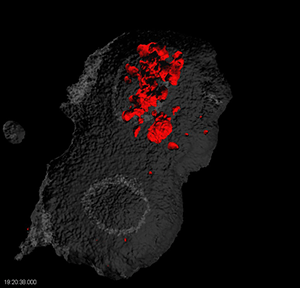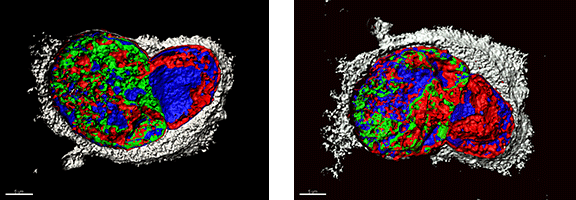Applications
 Part of the Oxford Instruments Group
Part of the Oxford Instruments Group
Expand
Collapse
 Part of the Oxford Instruments Group
Part of the Oxford Instruments Group
Stem Cell Biology
Dr. Hong-Wu Xin from the National Cancer Institute in Bethesda, Maryland, U.S. led a team of researchers who used Imaris software to study a unique type of cell division in cancer stem cells and to observe how cells undergoing this type of cell division interact with their microenvironment.
Studies have suggested that gastrointestinal cancers may develop in tissues containing stem cells that undergo a specific type of cell division called asymmetric cell division with non-random chromosomal cosegregation (ACD-NRCC). During ACD-NRCC, each stem cell chromosome conserves a template DNA strand during asymmetric cell division, which prevents the accumulation of mutations from DNA replication errors.

An arrested dividing cell shows asymmetric segregation of chromosomes (red). Images courtesy of Hong-Wu Xin.
“It is important to understand the mechanisms of ACD-NRCC in gastrointestinal cancer cells because it may provide the basis for novel cancer therapy against cancer stem cells,” Dr. Xin says.
Studying live cells
Previous studies examining ACD-NRCC used fixed cells, and thus couldn’t examine the gene expression involved in ACD-NRCC. Dr. Xin’s team isolated live cells undergoing ACD-NRCC to study with confocal microscopy and other analysis methods. The 3-D rendering capability of Imaris was a key part of this research.
The investigators used confocal microscopy to acquire 30 to 50 slices at 0.38-micron intervals. They then used Imaris software for 3D rendering of the Z-stacks. The researchers used a cutting plane to expose internal surfaces or made outer surfaces semi-transparent so that they could clearly observe nuclei position. The 3D images revealed two nuclei in the same cytoplasmic space without intervening cytoplasmic membrane during ACD-NRCC. This image analysis confirmed that ACD-NRCC does occur in a subpopulation of gastrointestinal cancer cells.
Other analysis revealed that ACD-NRCC can be regulated by the Wnt pathway, although more work is needed to better understand Wnt’s role in this type of cell division. Also, the researchers found that other cells in the cancer niche — which is made of surrounding non-stem cells — can alter the behavior of stem cells undergoing ACD-NRCC in a way that does not require cell-to-cell contact.
“Our findings provided the first molecular pathway map of ACD-NRCC, which may have implications on future targeted cancer therapy against cancer stem cells,” Dr. Xin says.

Three dimensional confocal microscopy images showing human liver cancer cells undergoing ACD-NRCC. Cells undergoing potential ACD-NRCC incorporated both nucleotides (green and red) into only one of the daughter cells’ nuclei while the other nucleus incorporated only one nucleotide (red).
In other work, the researchers have also shown that label-retaining cancer cells undergo active ACD-NRCC, express pluripotency genes, and initiate tumors with only 10 cells (Stem Cells, 2012). Label-retaining cancer cells are relatively resistant to chemotherapy (Annals of Surgery, 2013), targeted cancer therapy (GUT, 2013), and reported anti-CSC drugs (submitted). “We are searching for novel cancer drugs that can overcome the label-retaining cancer cells resistance, or abrogate the resistance of cancer stem cells,” Dr. Xin says.
Research Paper: Xin HW, Ambe CM, Ray S, Kim BK, Koizumi T, Wiegand GW, Hari D, Mullinax JE, Jaiswal KR, Garfield SH, Stojadinovic A, Rudloff U, Thorgeirsson SS, Avital I. Wnt and the Cancer Niche: Paracrine Interactions with Gastrointestinal Cancer Cells Undergoing Asymmetric Cell Division. J Cancer 2013; 4(6):447-457.
Author: Hong-Wu Xin, Itzhak Avital, and colleagues, National Cancer Institute, National Institutes of Health
Category: Case Study
